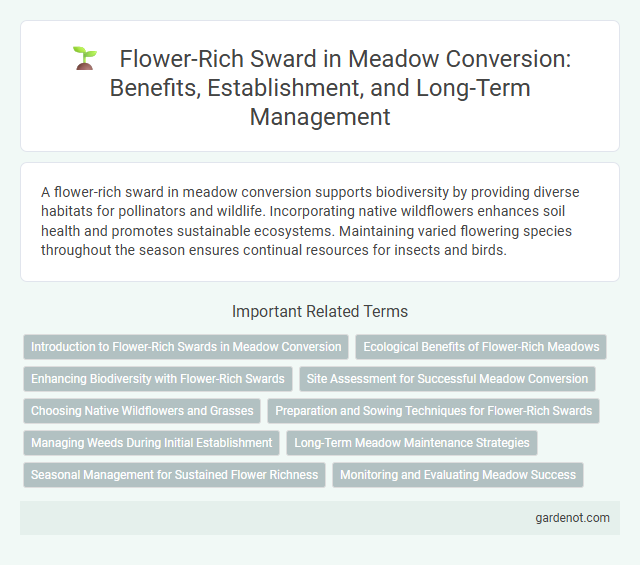A flower-rich sward in meadow conversion supports biodiversity by providing diverse habitats for pollinators and wildlife. Incorporating native wildflowers enhances soil health and promotes sustainable ecosystems. Maintaining varied flowering species throughout the season ensures continual resources for insects and birds.
Introduction to Flower-Rich Swards in Meadow Conversion
Flower-rich swards play a crucial role in meadow conversion by enhancing biodiversity and supporting pollinators such as bees and butterflies. These diverse plant communities contain a mix of native wildflowers and grasses that improve soil health and ecosystem resilience. Establishing flower-rich swards through careful seed selection and adaptive management promotes long-term ecological sustainability in converted meadows.
Ecological Benefits of Flower-Rich Meadows
Flower-rich meadows create diverse habitats that support pollinators such as bees, butterflies, and hoverflies, enhancing local biodiversity. These meadows contribute to soil health by promoting nutrient cycling and preventing erosion through dense root systems. Furthermore, they play a crucial role in carbon sequestration, aiding in climate regulation and ecosystem resilience.
Enhancing Biodiversity with Flower-Rich Swards
Flower-rich swards significantly enhance biodiversity by providing diverse habitats and food sources for pollinators such as bees, butterflies, and other beneficial insects. These swards improve soil health through diverse root systems and support a range of wildlife including birds and small mammals. Incorporating native wildflowers in meadow conversions maximizes ecological benefits and promotes sustainable ecosystem balance.
Site Assessment for Successful Meadow Conversion
Site assessment for successful meadow conversion involves evaluating soil composition, moisture levels, and sunlight exposure to promote a flower-rich sward. Identifying native wildflower species and existing seed banks helps tailor planting strategies for biodiversity and soil health. Regular monitoring of nutrient levels and invasive species ensures the establishment and persistence of a vibrant, diverse meadow ecosystem.
Choosing Native Wildflowers and Grasses
Selecting native wildflowers and grasses is essential for creating a flower-rich sward that supports local biodiversity and thrives in the existing soil and climate conditions. Species such as oxeye daisy, common knapweed, and red fescue provide nectar for pollinators and stabilize soil structure, enhancing meadow resilience. Incorporating a diverse mix of native plants promotes ecological balance and ensures a sustainable, vibrant meadow ecosystem.
Preparation and Sowing Techniques for Flower-Rich Swards
Preparation for flower-rich swards requires soil testing and targeted nutrient management to create optimal conditions for diverse wildflower species. Techniques such as scarification and shallow cultivation improve seed-to-soil contact, enhancing germination rates for native flowers. Precise timing of sowing, typically in early spring or autumn, ensures seeds establish before competitive grasses dominate, promoting a vibrant and sustainable meadow ecosystem.
Managing Weeds During Initial Establishment
Managing weeds during the initial establishment of a flower-rich sward is crucial to ensure successful meadow conversion. Regular monitoring and timely removal of invasive weed species such as thistles, nettles, and docks prevent competition for nutrients and light, promoting the growth of desirable wildflowers. Employing mechanical methods like mowing or spot-treating with selective herbicides enhances the establishment of native flora by reducing weed pressure in the first critical months.
Long-Term Meadow Maintenance Strategies
Flower-rich swards require long-term meadow maintenance strategies that emphasize periodic mowing and controlled grazing to promote floral diversity and soil health. Implementing a rotation schedule that avoids cutting during peak flowering seasons supports seed dispersal and plant regeneration. Monitoring nutrient levels and minimizing fertilizer use help maintain the delicate balance needed for native wildflowers to thrive over time.
Seasonal Management for Sustained Flower Richness
Seasonal management of flower-rich swards involves timed mowing and selective grazing to promote diverse wildflower species and prevent dominant grasses from overtaking the meadow. Implementing a late summer cut after seed set encourages natural regeneration and supports pollinators throughout the bloom period. Maintaining a seasonal grazing regime with light stock pressure enhances structural diversity and flower abundance in restored meadows.
Monitoring and Evaluating Meadow Success
Monitoring flower-rich sward involves regular surveys to assess plant species diversity, flowering abundance, and overall vegetation health. Evaluating meadow success requires tracking key indicators such as species richness, cover of native wildflowers, and presence of pollinators to gauge ecological balance. Data collected guides adaptive management practices ensuring sustained biodiversity and habitat quality.
Flower-rich sward Infographic

 gardenot.com
gardenot.com